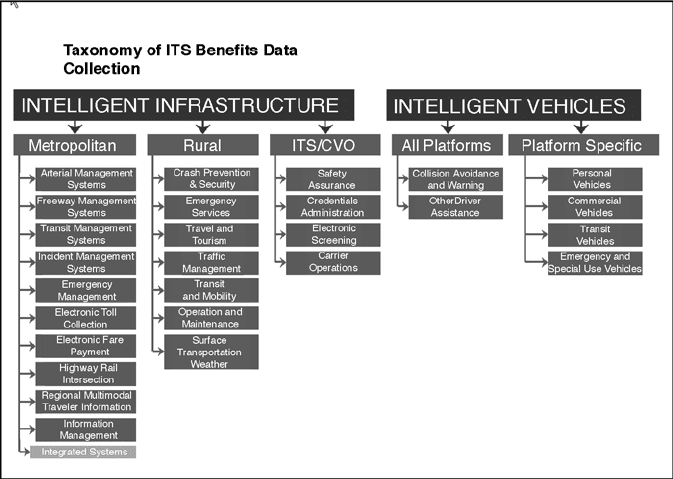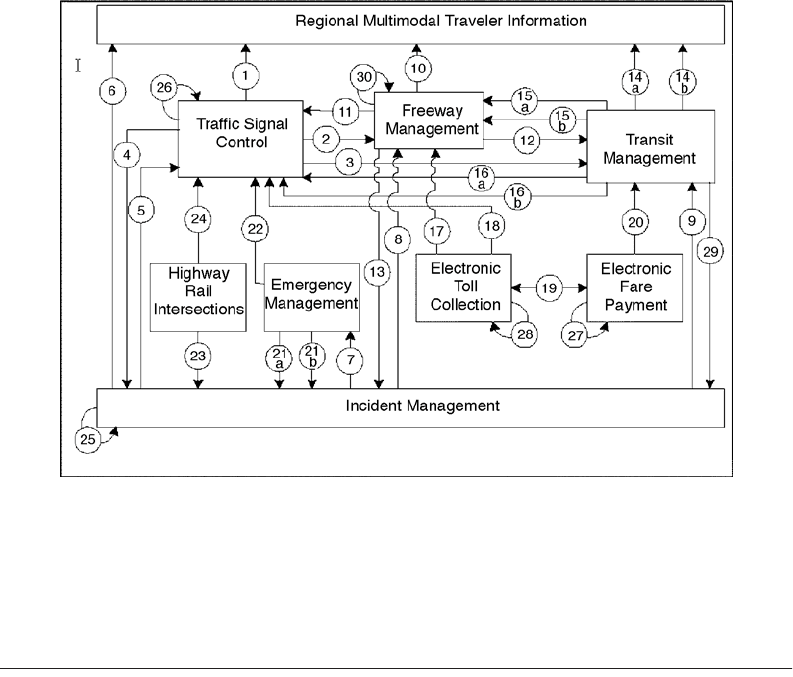Wai-Fah Chen.The Civil Engineering Handbook
Подождите немного. Документ загружается.

Intelligent Transportation Systems 65-19
traveler information and by operating traffic management and control systems. This quantum leap will
have a major impact on today’s lifestyle [6].
Attempting to quantify the benefits of widely deployed ITS technologies at the birth of what was then
IVHS was similar to what planners of the U.S. interstate highway system tried to do in the 1950s. It was
impossible to anticipate all of the ways that applications of ITS technology may affect society, just as
planners of the interstate highway system could not have anticipated all of its effects on American society.
Recognizing the importance of the issue, however, Mobility 2000, an ad hoc coalition of industry,
university, and federal, state, and local government participants, whose work led to the establishment of
ITS America, addressed the potential benefits of applying ITS technology in the United States. Numerous
benefits were predicted for urban and rural areas and for targeted groups, such as elderly and disadvan-
taged travelers. Positive benefits were also found in regard to the environment [2].
ITS represents a wide collection of applications, from advanced signal control systems to ramp meters
to collision warning systems. In order to apply ITS technologies most effectively, it is important to know
which technologies are most effectively addressing the issues of congestion and safety. Some technologies
provide more cost-effective benefits than others, and as technology evolves, the choices to deployers
change. Often, several technologies are combined in a single integrated system, providing synergistic
benefits that exceed the benefits of any single technology. It is important to know which technologies
and technology combinations provide the greatest benefits, so that transportation investments can be
applied most effectively to meet the growing transportation demands of our expanding economy [40].
Since 1994, the U.S. DOT’s ITS Joint Program Office has been actively collecting information on the
impacts that ITS and related projects have on the operation and management of the nation’s surface
transportation system. The evaluation of ITS is an ongoing process. Significant knowledge is available
for many ITS services, but gaps in knowledge also exist [39]. In general, all ITS services have shown some
positive benefit, and negative impacts are usually outweighed by other positive results. For example,
higher speeds and improved traffic flow result in increases in nitrous oxides, while other measures that
indicate increased emissions, such as fuel consumption, travel time, and delay, are reduced. Because of
the nature of the data, it is often difficult to compare data from one ITS project to another. This is because
of the differences in context or conditions between different ITS implementations. Thus, statistical
analysis of the data is not done across data points. In several cases, ranges of reported impacts are
presented and general trends can be discussed. These cases include traffic signal systems, automated
enforcement, ramp metering, and incident management [39].
Most of the data collected to date are concentrated within metropolitan areas. The heaviest concen-
trations of such data are in arterial management systems, freeway management, incident management,
transit management, and regional multimodal traveler information. Most of the available data on traffic
signal control systems are from adaptive traffic control. For freeway management, most data are concen-
trated around benefits related to ramp metering. There are also recent studies on the benefits of ITS at
highway–rail intersections.
There has been an increase in the implementation and evaluation of rural ITS. Several state and
national parks are now examining and implementing improved tourism and travel information systems,
and several rural areas are implementing public travel services. Many states are examining the benefits
of incorporating ITS, specifically weather information, into the operation and maintenance of facilities
and equipment. Many of the data reported for rural ITS are concentrated in the areas of crash prevention
and security. A significant amount of information is available for road weather management activities,
including winter weather–related maintenance, pavement condition monitoring, and dissemination of
road weather information.
ITS for Commercial Vehicle Operations (ITS/CVO) continues to provide benefits to both carriers and
state agencies. ITS/CVO program areas usually report benefits data from directly measurable effects.
Therefore, it might be expected that these data are accurate and only a few data points would be necessary
to convince carriers, states, and local authorities of the possible benefits of implementing these systems.
To date, most of the data collected for ITS/CVO are for cost, travel time, and delay savings for carrier
operations.
© 2003 by CRC Press LLC

65-20 The Civil Engineering Handbook, Second Edition
ITS program areas and user services associated with driver assistance and specific vehicle classes are
still being developed and planned. As market penetrations increase and improved systems are developed,
there will be ample opportunity to measure and report data based on actual measurements [39].
Taxonomy and Measures of Effectiveness
To track the progress toward meeting ITS program goals, the JPO has identified and established a set of
measures of effectiveness. These measures are termed “A Few Good Measures” and are used as a standard
in the reporting of much of the ITS benefits data currently available. Data collected are not limited to
these measures; additional measures are also reported when available. The few good measures are:
•Safety: usually measured by impacts on crashes, injuries, fatalities
•Delay: usually measured in units of time
•Cost: measured in monetary amount
• Effective capacity: measured in throughput or traffic volumes
•Customer satisfaction: usually results from user surveys
• Energy and environment: usually measured in fuel consumption and emissions
The benefits database desk reference (Fig. 65.3) provides a brief summary of the metropolitan data
available in the online database. The desk reference is updated regularly and is also available at the
database web site. It is based on a taxonomy developed [42] for the classification of benefits (Fig. 65.2).
A cost database is also available and can be found through the ITS web page of the U.S. DOT [44],
with more details in reference 45. The ITS unit cost database consists of cost estimates for a set of ITS
elements. These cost estimates are categorized as capital, and operating and maintenance (O&M) costs
(also known as nonrecurring and recurring costs, respectively). These costs are presented in a range to
capture the lows and highs of the cost elements from the different data sources identified on the cost
data sources page. The cost data are useful in developing project cost estimates during the planning
process. However, the user is encouraged to find local and regional data sources and current vendor data
FIGURE 65.2 ITS benefits taxonomy. (Mitretek Systems, Taxonomy for Classification of ITS Benefits, Depart-
ment of Transportation ITS JPO, Washington, D.C., June 2000.)
© 2003 by CRC Press LLC

Intelligent Transportation Systems 65-21
to perform a more detailed cost estimate. The set of ITS elements is based primarily on the unit cost
elements in the National ITS Architecture Cost Analysis and the ITS Deployment Analysis System (IDAS)
equipment list. IDAS is software developed by the Federal Highway Administration [44] that can be used
in planning for ITS deployment. IDAS can estimate relative costs and benefits for more than 60 types of
ITS investments. Practitioners will find a number of useful features that enhance ITS planning.
FIGURE 65.3 Metropolitan benefits.
Metropolitan Benefits By Program Area
Program Area/Benefit Measure Summary
Arterial
Management
Systems
Safety Improvements Automated enforcement of traffic signals has reduced red-light violations
20–75%.
Delay Savings Adaptive signal control has reduced traffic delay 14–44%. Transit signal
priority has reduced bus journey times by 7%.
Throughput
Customer Satisfaction In Michigan, 72% of surveyed drivers felt “better off” after signal control
improvements.
Cost Savings Transit signal priority on a Toronto Transit Line allowed same level-of-
service with less rolling stock.
Environmental Improvements to traffic signal control have reduced fuel consumption
2–13%.
Other Between 1969 and 1976, traffic signal preemption systems in St. Paul,
MN, reduced emergency vehicle accidents by 71%.
Freeway
Management
Systems
Safety Improvements Ramp Metering has shown a 15–50% reduction in crashes.
Delay Savings In Minneapolis-St. Paul, MN, ramp metering has reduced freeway travel
time 22%, for an annual savings of 25,121 vehicle-hours.
Throughput Ramp metering has increased throughput 13–16%.
Customer Satisfaction After the Twin Cities ramp meter shutdown test, 69% of travelers
supported modified continued operations.
Cost Savings The GA Navigator (integrated system) supported incident delay
reductions, for an annual savings of $44.6 million.
Environmental
Other Ramp metering has shown an 8–60% increase in freeway speeds.
Transit
Management
Systems
Safety Improvements In Denver, AVL systems with silent alarms have supported a 33%
reduction in bus passenger assaults.
Delay Savings CAD/AVL has improved on-time bus performance 9–23%.
Throughput
Customer Satisfaction In Denver, installation of CAD/AVL decreased customer complaints by 26%.
Cost Savings In San Jose, AVL has reduced paratransit expense from $4.88 to $3.72
per passenger.
Environmental
Other More efficient bus utilization has resulted in a 4–9% reduction in fleet size.
Incident
Management
Systems
Safety Improvements In San Antonio, integrated VMS and incident management systems
decreased accidents by 2.8%.
Delay Savings Incident management in city and regional areas has saved 0.95–15.6
million vehicle-hours of delay per year.
Throughput
Customer Satisfaction Customers have been very satisfied with service patrols (hundreds of
letters).
Cost Savings Cost savings have ranged from 1–45 million dollars per year, depending
on coverage area size.
Environmental Models of the Maryland CHART system have shown fuel savings of 5.8
million gallons per year.
Other The I-95 TIMS system in PA has decreased highway incidents 40% and
cut closure time 55%.
Emergency
Management
Systems
Safety Improvements In Palm Beach, GPS/AVL systems have reduced police response times
by 20%.
Delay Savings
Throughput
Customer Satisfaction 95% of drivers equipped with PushMe Mayday system felt more secure.
Cost Savings
Environmental
Other
© 2003 by CRC Press LLC

65-22 The Civil Engineering Handbook, Second Edition
One of the powerful aspects of ITS is the capability of components to share information and resources
with other components. This integration of individual components allows the formation of a unified regional
traffic control and management system. To better describe the flow of information between components, a
number of integration links have been developed for the metropolitan ITS infrastructure. These links represent
both inter- and intracomponent sharing of information. Each of the links has been assigned a number and
an origin or destination path from one component to another. For example, metropolitan integration link
number 29 is from transit management to incident management and represents the ability of transit agencies
to notify incident management agencies of incident location, severity, and type. Figure 65.4 depicts the links
in metropolitan integration, and definitions of the links can be found in Table 65.10 in the Appendix [43].
For a more complete understanding of these components, integration, and how they can be interpreted,
refer to the following documents: “Tracking the Deployment of Integrated Metropolitan Intelligent
Transportation Systems Infrastructure in the USA: FY 1997 Results,” Document 5883, September 1998;
FIGURE 65.3 Metropolitan benefits (continued).
Metropolitan Benefits By Program Area
Program Area/Benefit Measure Summary
Electronic Toll
Collection
Safety Improvements Driver uncertainty about congestion contributed to a 48% increase in
accidents at E-PASS toll stations in Florida.*
Delay Savings The New Jersey Turnpike Authority (NJTA) E-Zpass system has reduced
vehicle delay by 85%.
Throughput Tappan Zee Bridge: Manual lane 400–450 vehicles/hour (vph), ETC lane
1000 vph.
Customer Satisfaction
Cost Savings ETC has reportedly reduced roadway maintenance and repair costs by 14%
Environmental NJTA models indicate E-Zpass saves 1.2 mil gallons of fuel per yr, 0.35 tons
of VOC per day, and 0.056 tons NOx per day.
Other 20% of travelers on two bridges in Lee County, FL, adjusted their departure
times as a result of value pricing at electronic tolls.
Electronic Fare
Payment
Safety Improvements
Delay Savings
Throughput
Customer Satisfaction Europe has enjoyed a 71–87% user acceptance of smart cards for transit/city
coordinated services.
Cost Savings The Metro Card System saved New York approximately $70 million per year.
Environmental
Other
Highway Rail
Intersections
Safety Improvements In San Antonio, VMS with railroad crossing delay information decreased
crashes by 8.7%.
Delay Savings
Throughput
Customer Satisfaction School bus drivers felt in-vehicle warning devices enhanced awareness of
crossings.
Cost Savings
Environmental Automated horn warning systems have reduced adjacent noise impact areas
by 97%.
Other
Regional
Multimodal
Traveler
Information
Safety Improvements IDAS models show the ARTIMIS traveler information system has reduced
fatalities 3.2% in Cincinnati and Northern Kentucky.
Delay Savings A model of SW Tokyo shows an 80% decrease in delay if 15% of vehicles
shift their departure time by 20 min.
Throughput
Customer Satisfaction 38% of TravTek users found in-vehicle navigation systems useful when
travelling in unfamiliar areas.
Cost Savings
Environmental EPA-model estimates of SmarTraveler impacts in Boston show 1.5% less
NOx and 25% less VOC emissions.
Other Models of Seattle show freeway-ATIS is 2x more effective in reducing delay
if integrated with arterial ATIS.
Source: http://www.benefitcost.its.dot.gov *Database also includes negative impacts of ITS Date: 12/31/2001
© 2003 by CRC Press LLC

Intelligent Transportation Systems 65-23
and “Measuring ITS Deployment and Integration,” Document 4372, January 1999. Both documents are
available on the FHWA electronic document library [44].
Figure 65.4 illustrates the numbered links that represent the flow of information between metropolitan
ITS components. Much of the data collected regarding integration illustrates benefits to delay and travel
time savings or cost savings. A few evaluation studies are currently planned or in progress that may
FIGURE 65.3 Metropolitan benefits (continued).
Metropolitan Benefits By Measure
Benefit Measure/Program Area Summary
Safety
Improvements
Arterial Management Automated enforcement of traffic signal has reduced red-light violations
20–75%.
Freeway Management Ramp metering has shown a 15–50% reduction in crashes.
Transit Management In Denver, AVL systems with silent alarms have supported a 33% reduction
in bus passenger assaults.
Incident Management In San Antonio, integrated VMS and incident management systems
decreased accidents by 2.8%.
Emergency Management In Palm Beach, GPS/AVL systems have reduced police response times by
20%.
Electronic Toll Collection Driver uncertainty about congestion contributed to a 48% increase in
accidents at E-PASS toll stations in Florida.*
Electronic Fare Payment
Highway Rail Intersection In San Antonio, VMS with railroad crossing delay information decreased
crashes by 8.7%.
Regional Traveler Info. IDAS models show the ARTIMIS traveler information system has reduced
fatalities 3.2% in Cincinnati and Northern KY.
Delay Savings Arterial Management Adaptive signal control has reduced traffic delay 14–44%. Transit signal
priority has reduced bus journey times by 7%.
Freeway Management In Minneapolis-St. Paul, MN ramp metering has reduced freeway travel time
22%, for an annual savings of 25,121 vehicle-hours.
Transit Management CAD/AVL has improved on-time bus performance 9–23%.
Incident Management
Emergency Management
Electronic Toll Collection The New Jersey Turnpike Authority (NJTA) E-Zpass system has reduced
vehicle delay by 85%.
Electronic Fare Payment
Highway Rail Intersection
Regional Traveler Info. A model of SW Tokyo shows an 80% decrease in delay if 15% of vehicles
shift their departure time by 20 min.
Throughput Arterial Management
Freeway Management Ramp metering has increased throughput 13–16%.
Transit Management
Incident Management
Emergency Management
Electronic Toll Collection Tappan Zee Bridge: Manual lane 400–450 vehicles/hour (vph), ETC lane
1000 vph.
Electronic Fare Payment
Highway Rail Intersection
Regional Traveler Info.
Customer
Satisfaction
Arterial Management In Michigan, 72% of surveyed drivers felt “better off” after signal control
improvements.
Freeway Management After the Twin Cities ramp meter shutdown test, 69% of travelers supported
modified continued operations.
Transit Management In Denver, installation of CAD/AVL decreased customer complaints by 26%.
Incident Management Customers have been very satisfied with service patrols (hundreds of
letters).
Emergency Management 95% of drivers equipped with PushMe Mayday system felt more secure.
Electronic Toll Collection
Electronic Fare Payment Europe has enjoyed a 71–87% user acceptance of smart cards for
transit/city coordinated services.
Highway Rail Intersection School bus drivers felt in-vehicle warning devices enhanced awareness of
crossings.
Regional Traveler Info. 38% of TravTek users found in-vehicle navigation systems useful when
travelling in unfamiliar areas.
© 2003 by CRC Press LLC

65-24 The Civil Engineering Handbook, Second Edition
include results for several integration links. Few data have been reported for components that use
information collected using arterial management (links 1 to 4). It is expected that the primary benefit
for these integration links would be delay and travel time savings. The sharing of information between
FIGURE 65.3 Metropolitan benefits (continued).
Metropolitan Benefits By Measure
Benefit Measure/Program Area Summary
Customer
Satisfaction
Arterial Management In Michigan, 72% of surveyed drivers felt “better off” after signal control
improvements.
Freeway Management After the Twin Cities ramp meter shutdown test, 69% of travelers supported
modified continued operations.
Transit Management In Denver, installation of CAD/AVL decreased customer complaints by 26%.
Incident Management Customers have been very satisfied with service patrols (hundreds of
letters).
Emergency Management 95% of drivers equipped with PushMe Mayday system felt more secure.
Electronic Toll Collection
Electronic Fare Payment Europe has enjoyed a 71–87% user acceptance of smart cards for
transit/city coordinated services.
Highway Rail Intersection School bus drivers felt in-vehicle warning devices enhanced awareness of
crossings.
Regional Traveler Info. 38% of TravTrek users found in-vehicle navigation systems useful when
travelling in unfamiliar areas.
Cost Savings Arterial Management Transit signal priority on a Toronto Transit Line allowed same level-of-service
with less rolling stock.
Freeway Management The GA Navigator (integrated system) supported incident delay reductions,
for an annual savings of $44.6 million.
Transit Management In San Jose, AVL has reduced paratransit expense from $4.88 to $3.72 per
passenger.
Incident Management Cost savings have ranged from 1–45 million dollars per year, depending
on coverage area size.
Emergency Management
Electronic Toll Collection ETC has reportedly reduced roadway maintenance and repair costs by
14%.
Electronic Fare Payment The Metro Card System saved New York approximately $70 million per year.
Highway Rail Intersection
Regional Traveler Info.
Environmental Arterial Management Improvements to traffic signal control have reduced fuel consumption 2–13%.
Freeway Management
Transit Management
Incident Management Models of the Maryland CHART system have shown fuel savings of 5.8
million gallons per year.
Emergency Management
Electronic Toll Collection NJTA models indicate E-Zpass saves 1.2 mil gallons of fuel per yr, 0.35 tons
of VOC per day, and 0.056 tons NOx per day.
Electronic Fare Payment
Highway Rail Intersection Automated horn warning systems have reduced adjacent noise impact
areas by 97%.
Regional Traveler Info. EPA-model estimates of SmarTraveler impacts in Boston show 1.5% less
NOx and 25% less VOC emissions.
Other Arterial Management Between 1969 and 1976, traffic signal preemption systems in St. Paul, MN,
reduced emergency vehicle accidents by 71%.
Freeway Management Ramp metering has shown an 8–60% increase in freeway speeds.
Transit Management More efficient bus utilization has resulted in a 4–9% reduction in fleet size.
Incident Management The I-95 TIMS system in PA has decreased highway incidents 40% and
cut closure time 55%.
Emergency Management
Electronic Toll Collection 20% of travelers on two bridges in Lee County, FL, adjusted their departure
times as a result of value pricing at electronic tolls.
Electronic Fare Payment
Highway Rail Intersection
Regional Traveler Info. Models of Seattle show freeway-ATIS is 2x more effective in reducing delay
if integrated with arterial ATIS.
Source: http://www.benefitcost.its.dot.gov * Database also includes negative impacts of ITS Date: 12/31/2001
© 2003 by CRC Press LLC

Intelligent Transportation Systems 65-25
arterial management and freeway management (links 2 and 11), which can be used to change ramp-
metering rates and traffic signal times, may yield significant advantages [43].
65.7 Five-Year Plan [38]
With the passage of the Transportation Equity Act for the 21st Century in 1998, Congress reaffirmed the
role of the U.S. DOT in advancing the development and integrated deployment of ITS technologies. A
five-year plan was developed presenting the U.S. DOT’s goals, key activities, and milestones for the
National ITS Program for FY 1999 through 2003.
Transition from Research to Deployment
Under ISTEA, the National ITS Program focused primarily on research, technology development, and
field testing that advanced the state of technology, demonstrated substantial public benefits, and fostered
new models of institutional cooperation. The program began to lay the foundation for an information
and communications infrastructure that would enable the nation to realize the vision set forth by
Congress — to manage multiple transportation facilities as unified systems for greater efficiency, safety,
customer service, and quality of life. TEA-21 continues the legacy of ISTEA by building on the success
of research and development to date. Today, many ITS technologies are available, and the National ITS
Program will shift its emphasis accordingly to the deployment of proven ITS technologies in an integrated
fashion, while continuing to advance ITS capabilities through further research.
Intelligent Infrastructure and Intelligent Vehicles
The National ITS Program focuses on two main objectives: deployment of intelligent infrastructure and
testing and evaluation of intelligent vehicle technologies. Intelligent infrastructure and intelligent vehicles
provide the information and control needed to better manage surface transportation facilities (highways,
roads, transit, and rail), to improve the safety of vehicles operating on those facilities, and to help users
FIGURE 65.4 Metropolitan integration links. (From Mitretek Systems, ITS Benefits: Data Needs Update 2000,
prepared in connection with ITS Benefits Data Needs Workshop, August 2000.)
© 2003 by CRC Press LLC
65-26 The Civil Engineering Handbook, Second Edition
of all modes make better decisions about travel. Intelligent infrastructure is the necessary network of
technologies — a communications and information backbone — that supports and unites key ITS
services for metropolitan, rural, statewide, and commercial vehicle application. Intelligent vehicle tech-
nologies improve safety and enhance mobility of the vehicles that operate on our roadways. Such
technologies apply to four classes of vehicles: light vehicles (passenger cars, vans, and light trucks), transit
vehicles (buses), commercial vehicles (trucks and interstate buses), and specialty vehicles (emergency
response, enforcement, and highway maintenance vehicles). ITS products and services must be seamlessly
integrated and interoperable. Over time, intelligent vehicles will increasingly interact with intelligent
infrastructure to yield even greater gains in mobility and traveler safety.
Intelligent infrastructure and intelligent vehicle objectives are addressed through four program areas:
metropolitan ITS infrastructure, rural ITS infrastructure, commercial vehicle ITS infrastructure, and
intelligent vehicles. Each program area targets a specific environment in which ITS capabilities are used.
The metropolitan and rural ITS infrastructure program areas address network-based technologies
deployed in those two settings. The commercial vehicle ITS infrastructure program area focuses on the
integrated technologies needed specifically for safety and administrative regulation of interstate trucking.
Finally, the intelligent vehicles program area targets in-vehicle safety systems for all users and geographic
settings.
ITS Program Strategies
The National ITS Program utilizes eight program strategies that work cooperatively to advance the state
of ITS across the country:
1. Conducting research: advances ITS infrastructure and vehicle capabilities by bringing technologies
from visionary concepts to viable and attractive solutions to transportation problems. Continued
research and development are necessary for increasing the real-time capabilities of ITS infrastruc-
ture components, improving intelligent vehicle capabilities, and developing successive generations
of ITS technologies.
2. Accelerating the development of standards: allows communications, surveillance, monitoring,
and computer processing systems to “speak” to each other, provides design guidance to manufac-
turers, and reassures purchasers that their systems will be compatible with other ITS elements.
3. Building professional capacity: ensures that transportation professionals across the country have
the skills necessary to design, deploy, operate, and maintain ITS systems. ITS requires new technical
skills, such as systems engineering, electronics, and communications, as well as institutional skills,
which include coalition building.
4. Creating funding incentives: encourages more widespread integration of ITS in metropolitan,
rural, and commercial vehicle settings. The overall trend in ITS funding has shifted from dedicated
special funds to the use of traditional transportation funding mechanisms such as the Highway
Tr ust Fund (including the Mass Transit Account). However, temporary funding incentives are still
necessary to foster integration and national interoperability and to accelerate deployment.
5. Providing guidance and technical assistance: aids implementers seeking to deploy integrated ITS.
The U.S. DOT provides specialized technical support through its federal field staff, through the
publication of guidance documents on best practices for ITS deployment, and with the Peer-to-
Peer Network, a resource composed of professionals from the private and public sectors who are
on call to provide short-term, no-cost technical assistance to transportation colleagues across the
country.
6. Ensuring consistency with the National ITS Architecture and standards: helps in planning for
ITS integration, reducing development time and cost, and laying the groundwork for a seamless
national ITS network. The U.S. DOT is working with stakeholders to develop federal policy on
consistency and is actively training stakeholders on this issue.
7. Evaluating the program: essential for understanding the value and effectiveness of ITS activities
and for measuring progress toward deployment goals. Tracking and evaluation are consistent with
© 2003 by CRC Press LLC
Intelligent Transportation Systems 65-27
the spirit of the Government Performance and Results Act and allow for the continual refinement
of the National ITS Program.
8. Showcasing benefits: communicates positive results realized through the use of ITS technologies
to multiple decision makers. By understanding the benefits of ITS, decision makers can compare
ITS to other transportation options when addressing local transportation issues. Showcasing
benefits also encourages integration of ITS systems. For example, deployment sites demonstrate
successful interjurisdictional working relationships and interagency coordination. By learning
about the deployment sites, decision makers better understand the operation and management
planning that is necessary to achieve integration in their areas.
Program Area Goals, Key Activities, Milestones
The eight ITS program strategies are used to meet specific goals in each of the four ITS program areas:
metropolitan, rural, and commercial vehicle infrastructure, and intelligent vehicles.
Metropolitan ITS Infrastructure Program Area
The metropolitan ITS program has demonstrated proven technologies for metropolitan application.
Model deployments in metropolitan settings have been successful and will continue to be showcases for
other areas. However, while individual systems are being purchased and installed around the country,
sites are just beginning to integrate systems across jurisdictions and modes. Since integration has been
limited, communities are not yet reaping the full benefits of ITS.
The metropolitan component of the National ITS Program is focused on meeting the goals for
integrated deployment laid out by former Secretary of Transportation Federico Peña in 1996 and reiter-
ated by former Secretary of Transportation Rodney Slater. Known as Operation TimeSaver, the U.S.
DOT’s objective is to facilitate integrated deployment of basic ITS services in 75 metropolitan areas by
2006. At present, 36 sites are considered to have some elements of integration, and additional sites show
the clear beginnings of integrated systems.
Goal
By 2003, the metropolitan program aims to have 64 sites achieve the Operation TimeSaver goal for
integrated deployment.
Key Activities and Milestones
The Operation TimeSaver goal will be met using all eight ITS program strategies as follows:
Conducting research: Traffic management and transit management research will be advanced under
TEA-21. New models for traffic management, such as the ITS Deployment Analysis System, have
been developed that more accurately represent the impact of ITS, allowing transportation planners
and designers to compare ITS with other transportation options more effectively. This model was
made available to the ITS planning community in 1999. A more sophisticated planning model —
the Transportation Analysis and Simulation System (TRANSIMS) — is under development and
will be available for initial use in 2002. In transit management, research will focus on the appli-
cation of integrated transit systems through operational tests in areas such as fleet management,
electronic fare payments, and traveler information. From 1999 to 2003, this research will be guided
by the Federal Transit Administration’s (FTA) 5-year research and technology plan.
Accelerating the development of standards: Development of standards, such as the National Trans-
portation Communications for ITS Protocol (NTCIP) and the Transit Communications Interface
Profiles (TCIP), will help facilitate integration in metropolitan areas. NTCIP will allow traffic
management and operations personnel to better control, manage, and monitor virtually all the
devices used on the roadway. TCIP will allow data to be shared among transit departments and
other operating entities, such as emergency response services and regional traffic management
centers. Because these standards are fundamental to metropolitan transportation operations, a
training course on each standard is necessary. The course on NTCIP is already available, on a request
© 2003 by CRC Press LLC
65-28 The Civil Engineering Handbook, Second Edition
basis, through the Institute of Traffic Engineers, and it will be available to stakeholders through
2003. A course on TCIP will be developed, with delivery expected to occur from 2001 to 2003.
Building professional capacity: Tr aining courses will continue to be offered on all aspects of metro-
politan ITS deployment. Courses will be updated as new information is made available.
Creating funding incentives: TEA-21 funding incentives are being offered to metropolitan public
sector applicants to support technical integration and jurisdictional coordination of ITS infra-
structure. Funding will be offered to both highway and transit projects, and the U.S. DOT will
work with Congress and the funding recipients to ensure that both the spirit and intent of TEA-
21 funding criteria are met. The U.S. DOT will allocate funding incentives annually based on
programmatic goals and the criteria defined in TEA-21. Funding available for integration was set
by TEA-21 at $75 million in 1999, $83 million in 2000, $83 million in 2001, $85 million in 2002,
and $85 million in 2003. A maximum of 90% of this funding is available to metropolitan areas.
Providing guidance and technical assistance: Special guidance and technical assistance are being
offered to transportation officials through federal field staff expertise, guidance documents, and
the Peer-to-Peer Network to assist in the planning, design, operation, and maintenance of met-
ropolitan ITS. In addition, federal field staff will work with their state and local partners to develop
“ITS service plans” that outline local technical guidance needs and plans for delivery. Development
of ITS service plans began with a focus on the top 78 metropolitan areas and has expanded over
time to include statewide concerns that typically involve rural ITS applications. The U.S. DOT
started with 62 service plans being implemented (49 from the top 78 metropolitan areas and 13
statewide plans) in FY 2000. U.S. DOT expects to expand over time and to include activities in
other metropolitan areas beyond the top 78.
Ensuring consistency with the National ITS Architecture and standards: The National ITS Architecture
and standards will be instrumental in catalyzing integrated ITS deployment across the country,
enabling areas to meet local needs while reducing development costs and risks, facilitating future
expansion capability, and fostering interoperability. Interim policy guidance on consistency with the
National ITS Architecture and standards was issued in 1999. The interim guidance was implemented
until release of the final policy; the final policy will be implemented through 2003 and beyond.
Evaluating the program: Program evaluations track levels of deployment and integration in the
75 metropolitan areas. Evaluations are being used to demonstrate ITS benefits and to measure
progress toward the Operation TimeSaver goal. From 1999 through 2003, U.S. DOT will conduct
annual tracking surveys, assemble the data received, and report findings. Using this information,
the metropolitan program will be refined as appropriate.
Showcasing benefits: The four metropolitan model deployment sites funded under ISTEA — Phoenix,
Arizona; Seattle, Washington; San Antonio, Texas; and the New York–New Jersey–Connecticut
metropolitan area — will continue to showcase the benefits of metropolitan ITS technologies
under TEA-21. These sites have brought together public and private sector partners to integrate
existing infrastructure with new traveler information systems. In addition, results of deployment
evaluations will be incorporated into publications to disseminate benefits information.
Through these eight strategies, the metropolitan ITS program will continue to pursue the deployment
of integrated, intelligent transportation systems — including advanced traffic management, traveler
information, and public transit systems — that will improve urban transportation management in the
75 largest urban areas. At the same time, there are 340 major metropolitan areas nationwide that could
benefit from advanced technologies, and the U.S. DOT’s field staff is working actively with all interested
communities.
Rural and Statewide ITS Infrastructure Program Area
Information technologies are currently being applied in rural settings to help improve the safety and
mobility of rural travelers. However, rural and statewide ITS applications are not yet as well defined as
metropolitan and commercial vehicle applications. Under TEA-21, the rural program will focus primarily
© 2003 by CRC Press LLC
